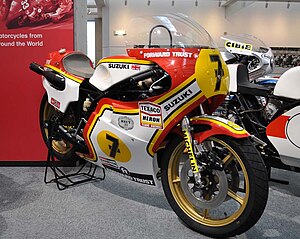Suzuki RG 500
| Suzuki | |
|---|---|
 Suzuki RG 500 (1977) |
|
| RG 500 | |
| Manufacturer | Suzuki |
| Production period | 1974 to 1985 |
| class | motorcycle |
| Motor data | |
| Two two-cylinder two- stroke engines in tandem design, water cooling, inlet with rotary plate valve | |
| Displacement (cm³) | ≤ 500 |
| Power (kW / PS ) | 90 hp at 10,500 rpm (1974) 120 hp at 13,000 rpm (1977) |
| Top speed ( km / h) | ≥ 280 (1974) |
| drive | Chain |
| Brakes | front: double disc, rear: disc |
| Empty weight (kg) | 137 (1984) |
The Suzuki RG 500 was a racing motorcycle from the Japanese manufacturer Suzuki , which was developed for the motorcycle world championship in the class up to 500 cm³. Barry Sheene won the motorcycle world championship in 1976 and 1977 .
History and technology
The racing motorcycle, known internally as the XR 14 , was completely redeveloped. A "square engine" was developed from two two-cylinder engines (bore / stroke 56 × 50.6 mm) in tandem. With four separate crankcases, each cylinder could be supplied with fuel via an external rotary plate valve with a 34 mm Mikuni carburettor. Suzuki used both fresh oil and separate lubrication ; ignition was carried out with a contactless thyristor magneto ignition from Denso . In the first models, the motor was initially cooled with a thermosiphon , later with pump circulation. The chassis, which in 1974 was still conventionally equipped with a tubular frame and two straight spring struts, was improved in the course of development.
In the first race of the motorcycle world championship in 1974 in France , Barry Sheene finished second behind Phil Read with the new design . The gearwheel power transmission of the twin motors to a common intermediate shaft caused difficulties again and again and initially prevented further success. The motorcycle world championship in 1975 brought Barry Sheene and the Suzuki RG 500, which had a superior engine performance, two victories ( Dutch TT and Sweden ), but the world championship could not be won against the reliability of the Yamaha OW 26 under Giacomo Agostini .
In 1976 Suzuki achieved the breakthrough with a new version. The engine has been redesigned (bore / stroke 54 × 54 mm) and the rear twin unit has been placed higher. Five wins and a second place for Sheene showed the superiority of this construction. In 1977 Sheene succeeded in repeating the success with six wins and a second place. In 1978 Sheene lost the title to Kenny Roberts senior on a Yamaha. 1981 won Marco Lucchinelli with a revised Suzuki RG 500 (u. A. Mono shock absorber rear), and in 1982 Franco Uncini the title. The last examples of the Suzuki RG 500, now known as the XR 85 , were used during the 1985 World Championship, but the Square Four engine was technically exhausted and had no chance against the design of Honda under the pilot Freddie Spencer .
In 1984 the Suzuki RG 500 Gamma , a series motorcycle derived directly from the racing machine, with an output of 95 hp at 9500 rpm (empty weight 181 kg), was presented to the press. The "thoroughbred racing machine with road approval" could be acquired by anyone from 1985 to 1989.
literature
- Joachim Kuch , Jürgen Gaßebner: Suzuki. Motorcycles since 1952. Motorbuch Verlag Stuttgart, 1st edition 2001, ISBN 3-613-02091-2 .
- Siegfried Rauch: Famous racing motorcycles - 150 old and new racing machines for Grand Prix use . 2nd Edition. Motorbuch Verlag, Stuttgart 1980, ISBN 3-87943-590-1 .
Web links
Individual evidence
- ^ Siegfried Rauch: Famous racing motorcycles. P. 236.
- ↑ Joachim Kuch, Jürgen Gaßebner: Suzuki. P. 112
- ^ Siegfried Rauch: Famous racing motorcycles. P. 236.
- ↑ Volker Rauch: Motorcycle World Championship 75th Motorbuch Verlag Stuttgart, ISBN 3-87943-389-5 , p. 24.
- ↑ Yamaha did not provide a factory team in 1976.
- ↑ Joachim Kuch, Jürgen Gaßebner: Suzuki. P. 113.